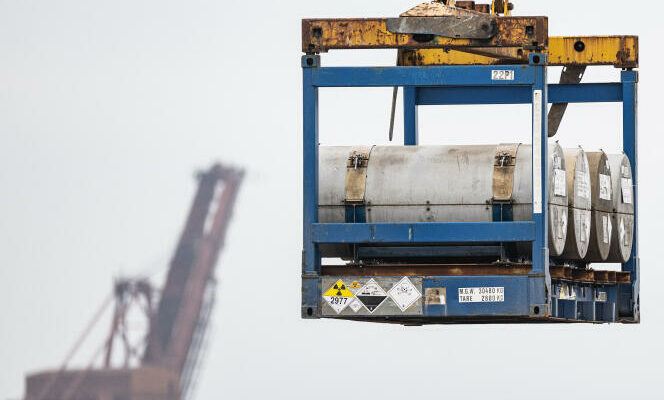The renewed appetite for nuclear power has an impact on the price of “yellow cake” (“yellow cake”), as the uranium concentrate is nicknamed. Since mid-January, the pound (around 450 grams) of the ore necessary for the operation of the power plants has risen above a symbolic bar: that of 100 dollars (around 92 euros), on the live market. Up to $106 on February 2 on the New York Mercantile Exchange. This is five times more than in 2016. And it is especially unprecedented since 2007 – the international price of uranium oxide had then peaked at 138 dollars.
Anticipating a rebound in demand, the price of this raw material rises at the same time as the number of new reactor projects, after years of dead calm. Example in December 2023, in Dubai, on the occasion of the 28e Conference of the Parties (COP28): twenty-two countries, including France, have expressed their ambition to triple civil nuclear capacities by 2050, compared to 2020. This involves banking on a source of energy low carbon, rather than coal and gas, which still dominate electricity production around the world.
This advert “revives the outlook for global uranium needs”even if it means feeding a “certain speculation” around stocks, analyzes Franco Michel-Sendis, fuel specialist within the Nuclear Energy Agency (NEA), an institution attached to the Organization for Economic Cooperation and Development.
“A significant increase in uranium supply will be required from the late 2020s to meet the demand created by the expected increase in global nuclear capacity”estimates Jonathan Cobb, spokesperson for the World Nuclear Association (WNA), based in London.
Reduce dependence on Russia
In the immediate future, the next commissionings are mainly expected in China. Out of seventeen reactors started around the world between 2021 and 2023, six come from the leading Asian power, according to the International Atomic Energy Agency. After twelve years behind the initial schedule, France remains more modest: it is still waiting for the start-up of the EPR pressurized reactor in Flamanville (Manche), scheduled for 2024. The government also intends to launch the construction of at least six EPR 2, for commissioning envisaged at the earliest for 2035. “Fuel requirements for the first charge are approximately 60% to 70% higher than for refills of operating plants”specifies Mr. Michel-Sendis.
You have 45% of this article left to read. The rest is reserved for subscribers.
